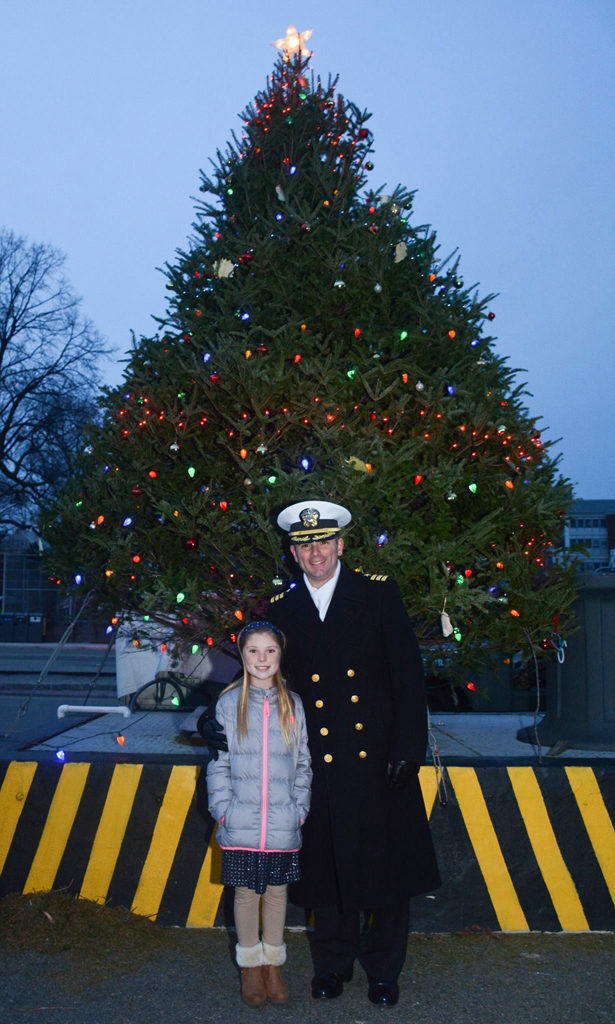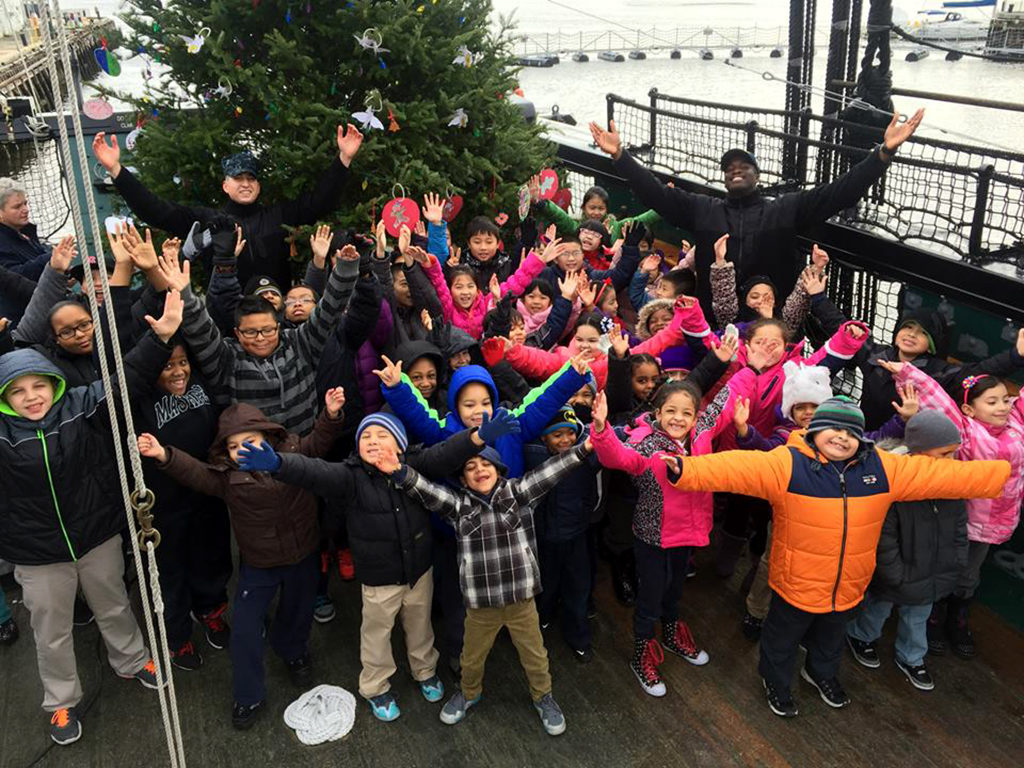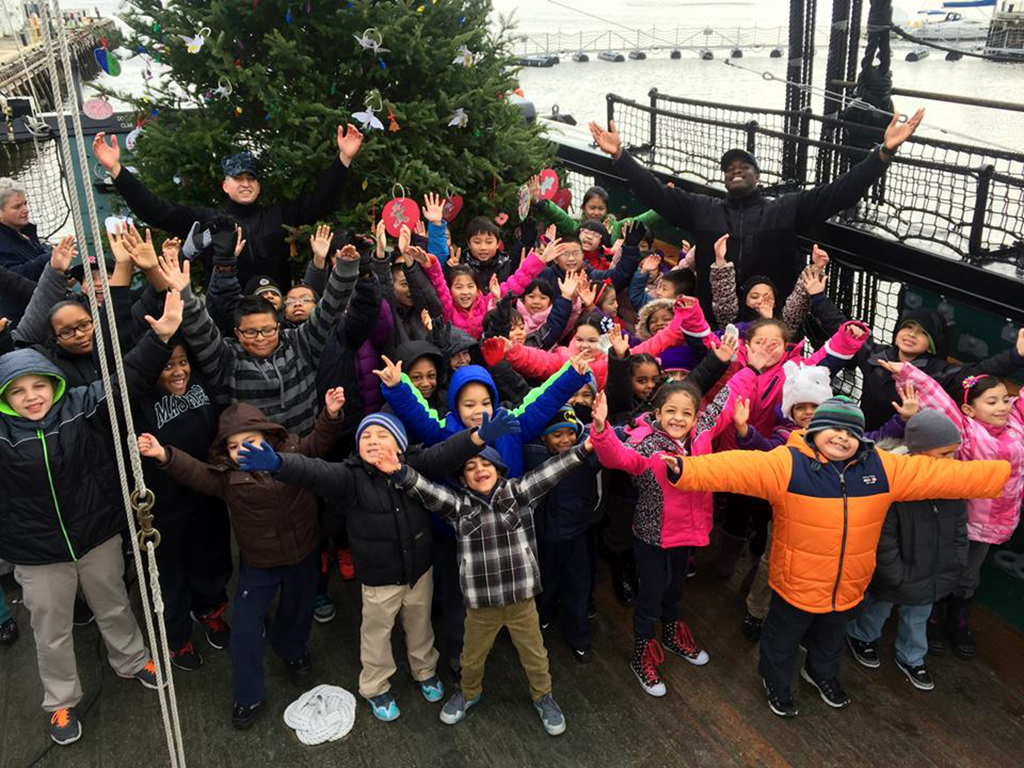Celebrating Christmas and the winter holiday season with a decorated evergreen tree is commonplace today. But 200 years ago in Calvinist New England, celebrating the birth of Christ on December 25th with lavish preparations, festivities and decorations was not the norm for the descendants of the Puritans. Widespread adoption of the decorated tree as a symbol of the holiday didn’t really take hold until the mid-19th century. In 1850, an image of Queen Victoria and Prince Albert celebrating Christmas with their children around a candle-lit tree appeared in the popular American publication Godey’s Ladies Book. This helped to make the idea of the decorated tree fashionable. Still later, Winslow Homer and Thomas Nast, in Harper’s Weekly or Frank Leslie’s Illustrated Newspaper, depicted post-Civil War American versions of the Christmas tree and other elements of the celebration, including Santa Claus.


When reading USS Constitution‘s early log books or journals, December 25th, as the Christmas holiday, frequently goes unremarked upon. In 1798, for instance, December 25th seems to have passed as just another day with the crew of Constitution loading supplies in Boston and getting the ship ready for her next deployment to the Caribbean Sea for the Quasi-War with France.
The first Christmas of the War of 1812 found Captain William Bainbridge in command of the recently nicknamed “Old Ironsides”. The ship was cruising for prize vessels around the time of the holiday. On December 29, 1812, Bainbridge and his crew received a “gift” of the season – a Royal Navy frigate. The nearly three hour battle with HMS Java proved costly for both sides. But Bainbridge, who had previously lost two U.S. Navy warships – to the French in the Quasi-War and infamously USS Philadelphia to the Tripolitans in the Barbary War – emerged triumphant and reaffirmed the success of USS Constitution and her crew.
![The Signing of the Treaty of Ghent, Christmas Eve, 1814, by Sir Amédée Forestier, 1914. [Smithsonian American Art Museum Gift of the Sulgrave Institution of the U.S. and Great Britain]](/wp-content/uploads/2016/12/treaty-of-ghent-smithsonian.jpg)
![The Signing of the Treaty of Ghent, Christmas Eve, 1814, by Sir Amédée Forestier, 1914. [Smithsonian American Art Museum Gift of the Sulgrave Institution of the U.S. and Great Britain]](/wp-content/uploads/2016/12/treaty-of-ghent-smithsonian.jpg)
Gift of the Sulgrave Institution of the U.S. and Great Britain]
“Ghent. 24 December 1814
My dear and honourable mother.
A Treaty of Peace between the United States and Great Britain has this day
been signed by the British and American Plenipotentiaries at this place….Of the Peace which we have at length concluded, it is for our Government, our Country and the world to
judge. It is not such as under more propitious circumstances might have been expected, and to be fairly
estimated must be compared not with our desires, but with what the situation of the parties and of the world
at and during the negotiation made attainable. We have abandoned no essential right, and if we have left
everything open for future controversy, we have at least secured to our country the power, at her own option
to extinguish the War.” [John Quincy Adams to Abigail Adams, December 24, 1814, Adams Family Papers, Massachusetts Historical Society]
![Brunei Harbor, by Cheslie D'Andrea, 1984. [USS Constitution Museum Collection.]](/wp-content/uploads/2016/12/2104-8_001-1024x675.jpg)
![Brunei Harbor, by Cheslie D'Andrea, 1984. [USS Constitution Museum Collection.]](/wp-content/uploads/2016/12/2104-8_001-1024x675.jpg)
One of the more forlorn Christmas seasons for Constitution was that of December, 1881. With Navy apprentices aboard, she took her last sail under her own power on October 2, 1881. When “Old Ironsides” returned to Newport, Rhode Island, a structural survey of the ship showed her to be no longer seaworthy. In late November she was towed to the New York Navy Yard and in the first half of December all materials of value were removed from the ship. On December 14, 1881, Constitution was decommissioned. According to an article in The New York Times,
“She has now taken her place in what is called ‘Rotten Row’…, and unless broken up and sold for relics, will be allowed to fall gradually to pieces.” [The New York Times, December 16, 1881]
![[USS Constitution Museum Collection. 1469.1]](/wp-content/uploads/2016/01/BierdstadtDec1881USSCM1469-1-1024x757.jpg)
![[USS Constitution Museum Collection. 1469.1]](/wp-content/uploads/2016/01/BierdstadtDec1881USSCM1469-1-1024x757.jpg)
USS Constitution was not allowed to fall to pieces, nor was she broken up for “relics”. She spent the next fifteen years at the Portsmouth Naval Shipyard as a receiving ship.
There is a “tradition” of placing Christmas trees at the tops of ships’ masts, but the origins of this tradition are obscure. In fact, this tradition may not have been all that prevalent, given the dearth of documentary evidence. However, one of the earliest references found is a quote from the journal of F.W. Tritton, a steward aboard the British SS Ghazee which was bound from Birkenhead to China, Japan, and Odessa in 1890. On Christmas Day, the Ghazee was off Kobe, Japan and Tritton wrote:
“Beautiful frosty day. Being Christmas Day we had the ship dressed [with flags]. On each of the masts we had a large holly tree and another on the bows and one on the flagstaff aft…” [Merseyside Maritime Museum, Ref. #DX/684/1/1]
In the spirit of this tradition, several American museum vessels display a single evergreen for the holiday season. Mystic Seaport Museum so decorates its whaling vessel the Charles W. Morgan and the National Park Service does the same for Friendship at the Salem Maritime National Historic Site.
USS Constitution‘s 20th century Christmases have often included a Christmas tree. Between 1931 and 1934, she was towed to the three U.S. coasts for her National Cruise. The first Christmas was spent in Miami, FL, and it is unknown if the ship was decorated with a tree. USS Grebe, a minesweeper which was “Old Ironsides'” tow vessel, was moored nearby. And while the crews may not have had a tree to celebrate, they did receive for Christmas Day 33 quarts of ice cream from Miami Ice Cream and Dairy Company and 35 mince pies from the Mary Alice Pie Company!
“Old Ironsides'” second Christmas was spent in Cristobal, Canal Zone of the Panama Canal. For the holiday, Constitution was decorated with four Christmas trees: one on the tip of the flying jibboom off her bow and one each on the tops of the three masts. One of the tallest crew members was assigned the task of helping to lash the trees to the very highest points on the masts. In honor of the holiday, the ship was closed to visitors and the sailors received a well-deserved rest from the daily round of thousands of guests who toured the ship. However, Constitution re-opened on December 26th and received 2717 visitors.
![Panama Canal, 1933 [Courtesy USS Constitution Museum]](/wp-content/uploads/2016/12/1552-2516-Panama-Canal-1933-1024x826.jpg)
![Panama Canal, 1933 [Courtesy USS Constitution Museum]](/wp-content/uploads/2016/12/1552-2516-Panama-Canal-1933-1024x826.jpg)
![Panama Canal, 1933 [Courtesy USS Constitution Museum]](/wp-content/uploads/2016/12/1552-5000-Panama-Canal-1933-1024x826.jpg)
![Panama Canal, 1933 [Courtesy USS Constitution Museum]](/wp-content/uploads/2016/12/1552-5000-Panama-Canal-1933-1024x826.jpg)
USS Constitution‘s third National Cruise Christmas was in San Diego, California. Several of her crew kept scrapbooks of the three-coast tour. Franciezek “Frank” Prusz, was one such sailor and he labeled a scrapbook page with the stamp “Christmas 1933/San Diego, Calif.” The page also includes two snapshots of a couple of the crew on the top deck, posing in front of a Christmas tree. Like their Christmas in Miami two years before, the men of both ships received the following food and sweets for the holiday: 15 gallons of milk and 7 gallons of ice cream from Western Diary Products and 30 pies from Kelly Kup Kakes.
![A page from the scrapbook of crewmember Franciezek "Frank" Prusz, who was aboard USS Constitution for the National Cruise, 1931-1934. This page features photographs and stamps from a winter visit to Panama and San Diego. [USS Constitution Museum Collection]](/wp-content/uploads/2016/12/USSCO090309_0042.jpg)
![A page from the scrapbook of crewmember Franciezek "Frank" Prusz, who was aboard USS Constitution for the National Cruise, 1931-1934. This page features photographs and stamps from a winter visit to Panama and San Diego. [USS Constitution Museum Collection]](/wp-content/uploads/2016/12/USSCO090309_0042.jpg)
Since at least the closure of the Charlestown Navy Yard in 1974, an evergreen tree has been installed aboard USS Constitution to lend a festive atmosphere to the ship for the holiday season. In recent years a new tradition has begun where visitors to the USS Constitution Museum are invited to make an ornament for the tree. In preparation for the annual Tree Lighting Ceremony, area school children stop by the ship to help decorate the tree. At different times the tree has been installed on the ship’s main hatch, in the center of the spar or upper deck, or been tucked aft in one of the corners of the spar deck. While Constitution has been in dry dock for her 2015-2017 restoration, the holiday tree has been displayed on the capstan block at the head of the dry dock.


Stop by the Charlestown Navy Yard and see USS Constitution‘s decorated tree, displayed through the New Year. Best wishes for a wonderful holiday season!
_____
The activity that is the subject of this blog article has been financed in part with Federal funds from the National Maritime Heritage Grant program, administered by the National Park Service, U.S. Department of the Interior, through the Massachusetts Historical Commission, Secretary of the Commonwealth William Francis Galvin, Chairman. However, the contents and opinions do not necessarily reflect the views or policies of the Department of the Interior, or the Massachusetts Historical Commission, nor does the mention of trade names or commercial products constitute endorsement or recommendation by the Department of the Interior, or the Massachusetts Historical Commission.
The Author(s)
Margherita Desy, Historian, Naval History and Heritage Command Detachment Boston
Historian, Naval History and Heritage Command
Margherita M. Desy is the Historian for USS Constitution at Naval History and Heritage Command Detachment Boston.
Kate Monea
Manager of Curatorial Affairs, USS Constitution Museum
Kate Monea is the Manager of Curatorial Affairs at the USS Constitution Museum.
